Marketing efforts typically incur the highest cost for most businesses. Without an effective and very comprehensive marketing plan, this expenditure may go to waste, as the marketing team pursues disjointed marketing activities that have little bearing on the overall marketing strategy that an organisation wishes to pursue.
A successful marketing plan should provide an overarching framework for the organisation’s marketing efforts, with systematic guidelines for the marketing team that take into consideration the target market for each product or service.
It should include steps for implementing marketing campaigns including offline and digital marketing, social media marketing, and whatever marketing materials or activities are deemed necessary for engaging existing and prospective customers. A social media campaign will typically assist with your business goal using the social media platforms your target audience spends most of their time in.
The effectiveness of the marketing plan should also be measurable through Key Performance Indicators (KPIs), which gauge the successful marketing strategy's impact, its contribution to establishing a sustainable competitive advantage, and its alignment with the marketing strategy outlines.
However, in order to create a marketing plan that meets all of these criteria, it is first necessary to understand the fundamental principles that underlie any marketing strategy.
Check out the following articles to learn more about marketing strategies:
- Go to Market Strategy vs Marketing Strategy: The Difference
- The 6-Step Go to Market Strategy Template for Growth
- 5 Go to Market Strategy Examples to Learn From
- How do I Start a B2B Marketing Campaign? | A 2023 Guide
The 7 Ps of Marketing
The roots of marketing strategy planning and implementation were first laid back in the 1960s, with the introduction of a concept that has since come to be known as “the seven Ps of marketing.” These are:
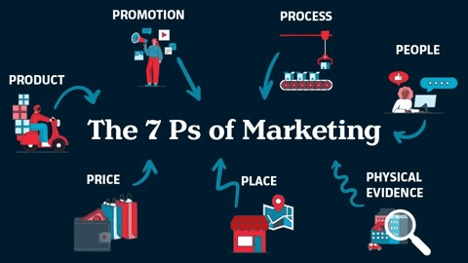
[Image source: Assemblo]
1. Product
Fundamental to the marketing plan is the product or service being promoted to the target market. Marketing strategy considerations surrounding the product include issues such as what it does to solve the problems or alleviate the pain points of the target customers, and what distinguishes it from other offerings on the market.
2. Price
A pricing strategy for the product or service is also fundamental to any marketing plan. Prices should be set taking into consideration factors such as production and distribution costs, and what target customers are willing to pay.
3. Promotion
Marketing activities concerning the promotional aspect of the marketing plan will typically cover a range of applications such as digital marketing, social media marketing, developing a marketing mix for offline media, and drawing up a content marketing strategy.
4. Place
Understanding the purchasing habits and behaviour of each buyer persona informs the marketing plan as to the best avenues and locations for displaying and selling the product or service. These may include channels for online and offline distribution.
5. People
At the organisational level, the “people” who will help in implementing the marketing plan include the leadership team, marketing team, and sales teams – in addition to non-human representatives involved in achieving marketing goals, such as chatbots and knowledge bases.
The organisation’s customer base can also play a role, through referrals, reviews, and word of mouth advertising within a social media marketing plan.
6. Process
The process to consider when creating a marketing plan is the sequence of operations that the organisation must follow in order to deliver a product or service to target customers.
7. Physical Evidence
The physical evidence aspect of a marketing mix consists of all the tangible proof that the commodity at the heart of the marketing plan actually exists, and the various ways in which the target audience can interact with and experience it. These may include physical stores, packaging, branding, and the brand positioning strategy that creates public awareness.
Creating the Marketing Plan
Developing a marketing plan is a systematic process that pulls in elements relating to an organisation’s marketing objectives, the nature of its target market, the unique selling proposition of the product or service, and the marketing tools and content strategy needed to promote it.
As a starting point, you can use a marketing plan template. You can typically acquire a free marketing plan template online, from organisations like Incisive Edge and HubSpot, which offer them as downloads.
Though marketing plan templates you obtain from one location may vary in specific details from a marketing plan template acquired from another source, the overall structure of the marketing plan itself should generally encompass some variation of the following components. These components include an effective marketing strategy, which outlines the approach to achieving marketing goals, a strong marketing strategy that bolsters the organization's market position, and successful marketing strategies that have demonstrated their effectiveness in driving business growth.
Business Summary or Executive Summary
The Business Initiatives section of a marketing plan describes the company's marketing strategy, and marketing goals, delving into specific projects to be undertaken by the marketing team. As well as describing marketing objectives, this section also considers how these goals will be measured.
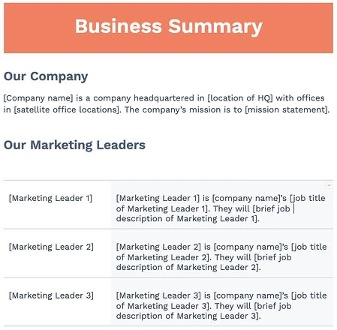
[Image source: HubSpot]
Business Initiatives or Marketing Objectives
The Business Initiatives section of a marketing plan describes the company's marketing strategy, and marketing goals, delving into specific projects to be undertaken by the marketing team. As well as describing marketing objectives, this section also considers how these goals will be measured.

[Image source: HubSpot]
Customer or Demographic Analysis
In customer or demographic analysis, the marketing plan considers the industry, niche, or target market for a product or service, and the various buyer personas that commodities are aimed at. This analysis encompasses both demographic traits and specific needs or pain points that the marketing plan identifies as relevant to the target market.
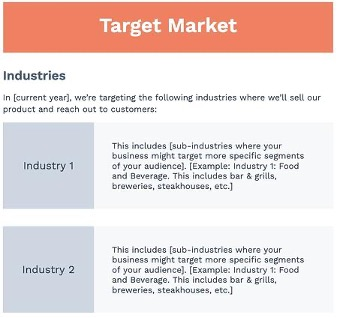
[Image source: HubSpot]
Market or Competitor Analysis
You won’t be marketing a product or service in a vacuum, so this section of the marketing plan considers the competition that you’ll be facing. Analysis should typically take in what other providers do well, where they are lacking, their existing market share, brand positioning strategy, and how your own unique selling proposition places you in comparison with them.
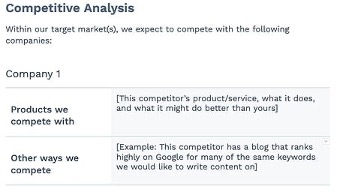
[Image source: HubSpot]
SWOT Analysis
SWOT is an acronym for Strengths, Weaknesses, Opportunities, and Threats. The results of your competitor and market research should have identified most if not all of these. Conducting a SWOT analysis as part of your marketing plan helps in establishing what may be lacking in your own or your competitor’s offerings, and further defining what your target customers are really looking for.
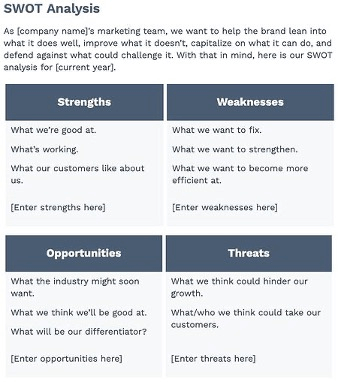
[Image source: HubSpot]
Marketing Strategy
In formulating a marketing strategy for your product or service, this part of the marketing plan draws heavily upon the seven Ps of marketing which we described earlier, to identify how best to wage a marketing campaign that effectively addresses the needs and expectations of your buyer personas.
Budgeting and Financial Projections
The budgeting section of your marketing plan will detail how resources should be allocated to your marketing department for achieving the marketing goals you have already established for the marketing campaign.
Note that a marketing plan is an ongoing process, so financial considerations for your marketing budget must take into account future projections for the coming month, quarter, or year.
Marketing Channels
This final section of the marketing plan considers all the marketing tools and marketing strategies that you'll need for outreach and promotion. These will include key considerations like your content marketing strategy, digital marketing strategies, and overall marketing strategy for all channels of engagement. At this point, you may need to develop separate and detailed plans for your various marketing efforts, such as a dedicated social media strategy and marketing plan or a content marketing plan template.
Final Thoughts
As you put your marketing plan into action, you will need to monitor and measure Key Performance Indicators (KPIs) and relevant metrics to gauge your level of marketing success. This performance monitoring should be conducted in line with SMART goals – that is, marketing objectives and business goals that are Specific, Measurable, Attainable, Relevant, and Time-bound. Speaking of time, it's a good idea to develop timelines that map out the progress of each specific project within your overall marketing plan. This includes key brand messaging, which communicates your brand's core values and identity, and marketing initiatives that drive your promotional and advertising efforts.
If one of your business objectives is to create a marketing plan that considers relevant marketing tactics and processes for your product or service offerings, Incisive Edge can help. To find out more, get in touch with us.







